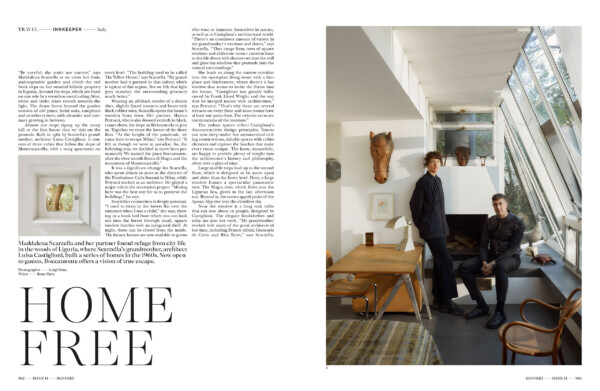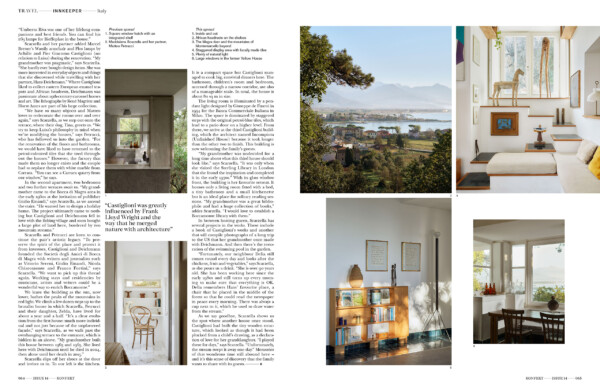Ilona Marx
Editorial work / Concepts / Texts
Home free
Interior Design / Travel
Maddalena Scarzella and her partner found refuge from city life in the woods of Liguria, where Scarzella’s grandmother, architect Luisa Castiglioni, built a series of homes in the 1960s. Now open to guests, Boccamonte offers a vision of true escape.
“Be careful: the stairs are narrow,” says Maddalena Scarzella as we cross her fruit-and-vegetable garden and climb the red brick steps on her wooded hillside property in Liguria. Around the steps, which are lined on one side by a vermilion metal railing, blue, white and violet irises stretch towards the light. The dense forest beyond the garden consists of old pines, holm oaks, camphors and strawberry trees, with oleander and rosemary growing in between.
Almost 100 steps zigzag up the steep hill to the first house that we visit on the grounds. Built in 1962 by Scarzella’s grandmother, architect Luisa Castiglioni, it consists of three cubes that follow the slope of Montemarcello, with a snug apartment on every level. “The building used to be called The Yellow House,” says Scarzella. “My grandmother had it painted in that colour, which is typical of this region. But we felt that light grey matches the surrounding greenery much better.”
Wearing an all-black combo of a denim shirt, slightly flared trousers and boots with thick rubber soles, Scarzella opens the house’s wooden front door. Her partner, Matteo Petrucci, who is also dressed entirely in black, comes down the slope in Birkenstocks to join us. Together we enter the lowest of the three flats. “At the height of the pandemic, we came here to escape Milan,” says Petrucci. “It felt as though we were in paradise. So, the following year, we decided to move here permanently. We named the place Boccamonte, after the river mouth Bocca di Magra and the mountains of Montemarcello.”
It was a significant change for Scarzella, who spent almost 10 years as the director of the Fondazione Carla Sozzani in Milan, while Petrucci worked as an architect. He played a major role in the renovation project. “Moving here was the best way for us to preserve the buildings,” he says.
Scarzella’s connection is deeply personal. “I used to sleep in the lowest flat over the summers when I was a child,” she says, showing us a bunk bed from which you can look out into the forest through small, square window hatches with an integrated shelf. At night, these can be closed from the inside. The former homes are now available to guests who want to immerse themselves in nature, as well as in Castiglioni’s architectural world. “There’s an enormous amount of variety in my grandmother’s windows and doors,” says Scarzella. “They range from rows of square windows and elaborate corner constructions to double doors with shutters set into the wall and glass bay windows that protrude into the natural surroundings.”
She leads us along the narrow corridor into the open-plan living room with a fireplace and kitchenette, where there’s a bay window that seems to invite the forest into the house. “Castiglioni was greatly influenced by Frank Lloyd Wright and the way that he merged nature with architecture,” says Petrucci. “That’s why there are several terraces on every floor and most rooms have at least one patio door. The exterior areas are continuations of the interiors.”
The indoor spaces reflect Castiglioni’s deconstructivist design principles. Guests can now sleep under her asymmetrical ceiling constructions, inhabit spaces with cubist elements and explore the hatches that make every room unique. The hosts, meanwhile, are happy to provide plenty of insight into the architecture’s history and philosophy, often over a glass of wine.
Large marble steps lead up to the second floor, which is designed to be more open and airier than the lower level. Here, a large window frames a spectacular panoramic view. The Magra river, which flows into the Ligurian Sea, glows in the late afternoon sun. Beyond it, the snow-capped peaks of the Apuan Alps rise into the cloudless sky.
Near the window is a long teak table that can seat about 10 people, designed by Castiglioni. The elegant bookshelves and sofas are also her work. “My grandmother worked with many of the great architects of her time, including Franco Albini, Giancarlo de Carlo and Rita Bravi,” says Scarzella. “Umberto Riva was one of her lifelong companions and best friends. You can find his e63 lamps for Bieffeplast in the house.”
Scarzella and her partner added Marcel Breuer’s Wassily armchair and Flos lamps by Achille and Pier Giacomo Castiglioni (no relation to Luisa) during the renovation. “My grandmother was pragmatic,” says Scarzella. “She hardly ever bought design items. She was more interested in everyday objects and things that she discovered while travelling with her partner, Hans Deichmann.” Where Castiglioni liked to collect eastern European enamel teapots and African headrests, Deichmann was passionate about 19th-century carousel horses and art. The lithographs by René Magritte and Horst Antes are part of his large collection.
“We have so many objects and Matteo loves to redecorate the rooms over and over again,” says Scarzella, as we step out onto the terrace, where their dog, Tina, greets us. “We try to keep Luisa’s philosophy in mind when we’re modifying the houses,” says Petrucci, who has followed us into the garden. “For the renovation of the floors and bathrooms, we would have liked to have returned to the petrol-coloured tiles that she used throughout the houses.” However, the factory that made them no longer exists and the couple had to replace them with white marble from Carrara. “You can see a Carrara quarry from our window,” he says.
In the second apartment, two bedrooms and two further terraces await us. “My grandmother came to the Bocca di Magra area in the early 1960s at the invitation of publisher Giulio Einaudi,” says Scarzella, as we ascend the stairs. “He wanted her to design a holiday home. The project ultimately came to nothing but Castiglioni and Deichmann fell in love with the fishing village and soon bought a large plot of land here, bordered by two mountain streams.”
Scarzella and Petrucci are keen to continue the pair’s artistic legacy. “To preserve the spirit of the place and protect it from investors, Castiglioni and Deichmann founded the Società degli Amici di Bocca di Magra with writers and journalists such as Vittorio Sereni, Giulio Einaudi, Nicola Chiaromonte and Franco Fortini,” says Scarzella. “We want to pick up this thread again. Working stays and residencies by musicians, artists and writers could be a wonderful way to enrich Boccamonte.”
We leave the building as the sun, now lower, bathes the peaks of the mountains in red light. We climb a few dozen steps up to the brutalist house in which Scarzella, Petrucci and their daughter, Zelda, have lived for about a year and a half. “It’s a clear evolution from the first house: much more individual and not just because of the unplastered façade,” says Scarzella, as we walk past the overhanging terrace to the entrance, which is hidden in an alcove. “My grandmother built this house between 1963 and 1965. She lived here with Deichmann until he died in 2004, then alone until her death in 2015.”
Scarzella slips off her shoes at the door and invites us in. To our left is the kitchen. It is a compact space but Castiglioni managed to cook big, convivial dinners here. The bathroom, children’s room and bedroom, accessed through a narrow corridor, are also of a manageable scale. In total, the house is about 80 sq m in size.
The living room is illuminated by a pendant light designed by Giuseppe de Finetti in 1934 for the Banca Commerciale Italiana in Milan. The space is dominated by staggered steps with the original petrol-blue tiles, which lead to a patio door on a higher level. From there, we arrive at the third Castiglioni building, which the architect named Incompiuta (Unfinished House) because it took longer than the other two to finish. This building is now welcoming the family’s guests.
“My grandmother was undecided for a long time about what this third house should look like,” says Scarzella. “It was only when she visited the Sterling Library in London that she found the inspiration and completed it in the early 1970s.” With its glass window front, the building is her favourite retreat. It houses only a living room fitted with a bed, a tiny bathroom and a small kitchenette but is an ideal place for solitary reading sessions. “My grandmother was a great bibliophile and had a huge collection of books,” addes Scarzella. “I would love to establish a Boccamonte library with them.”
In between hosting guests, Scarzella has several projects in the works. These include a book of Castiglioni’s works and another that will compile photographs of a long trip to the US that her grandmother once made with Deichmann. And then there’s the restoration of the swimming pool in the garden.
“Fortunately, our neighbour Delia still comes round every day and looks after the chickens, fruit and vegetables,” says Scarzella, as she pours us a drink. “She is over 90 years old. She has been working here since the early 1980s and still turns up every morning to make sure that everything is OK. Delia remembers Hans’ favourite place, a chair that he placed in the middle of the forest so that he could read the newspaper in peace every morning. There was always a cup next to it, which he used to draw water from the stream.”
As we say goodbye, Scarzella shows us the spot where another house once stood. Castiglioni had built the tiny wooden structure, which looked as though it had been plucked from a child’s drawing, as a declaration of love for her granddaughter. “I played there for days,” says Scarzella. “Unfortunately, the stream swept it away one day.” Memories of that wondrous time still abound here – and it’s this sense of discovery that the family wants to share with its guests.
Konfekt,
Spring 2024

